La ineficacia fatal del Responsable Jewellery Council (RJC) Cadena de Custodia Esquema
introducción del autor: This section of the Exposición de joyería ética discussing the RJC Chain of Custody Scheme documents weak enforcement and double standards that allow member companies that have committed atrocities to be certified as “responsable.”
This piece was originally published aquí.
Wikipedia writes that a chain of custody “refers to the chronological documentation or paper trail that records the sequence of custody, control, transfer, analysis, and disposition of physical or electronic evidence.
The Responsible Jewellery Council bases their certification on theirChain of Custody scheme.
Fundamentalmente, certification focuses on the control and transportation of minerals from a mine to the market.
If you have control of your chain of custody, doesn’t that allow for a measure of ethics?
Here’s the problem:
If we accept that traceability and transparency are thesole requisitos previos para el abastecimiento ético, podemos ignorar los derechos humanos del pasado y las atrocidades ambientales.
En otras palabras, Incluso las compañías que han cometido crímenes contra la humanidad pueden ser certificadas como "éticas" bajo un enfoque estrictamente de ética de la cadena de custodia, como señalé anteriormente., destinothis video sobre la certificación de AngloGold del Consejo de Joyería Responsable.
Again, aquí está la cláusula del abuelo que es, en mi vista, un encubrimiento de crímenes ocultos a la vista.
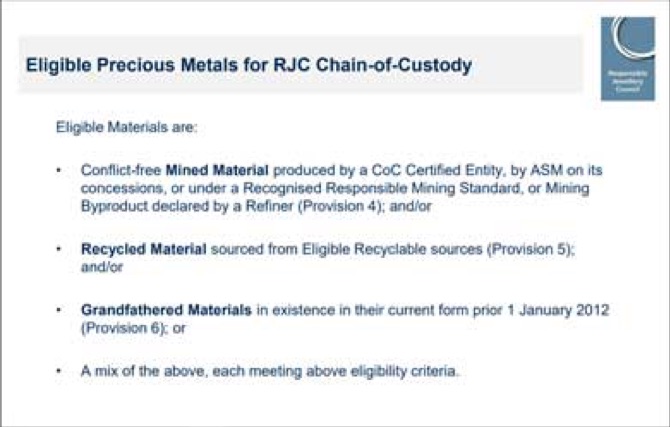
También podemos evitar el medio ambiente actual, social, labor, o cuestiones de derechos indígenas en un sitio minero particular.
Esto entra en juego porque el enfoque de la cadena de custodia con respecto a cómo las empresas mineras están certificadas como "éticas" estoda la empresainstead of sitio específico. Muchas compañías mineras a gran escala tienen múltiples minas en varios países.. They also may be partial shareholders of one mine.
Así, gold coming from a highly-regulated mine in Canada can be treated the same as gold coming from countries with weak or corrupt governments, with poor track records of regulating environmental and human rights.
Finalmente, if chain of custody is your main criteria for defining “ethical jewelry,” and you’re a large company which already controls its chain of custody, you’re basically just “certifying” what already exists.
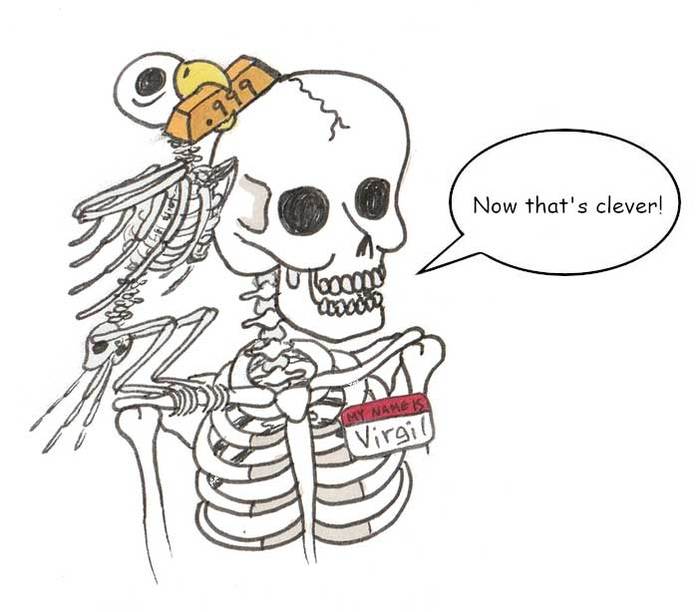
The fact of the matter is, without certain conditions, a chain of custody certification functions essentially as a diversionary tactic that can cover up atrocities.
Responsible Jewellery Council’s Certified Mining Companies
Le daré algunos ejemplos de cuán ineficaz puede ser un enfoque de cadena de custodia en relación con presuntas violaciones de derechos humanos y atrocidades ambientales de algunas de las compañías mineras certificadas por el Consejo..
Ya he notado las violaciones de AngloGold Ashanti en Ghana, pero aquí hay otra instancia deHuman Rights Watch en 2005, que detalla cómo en la República Democrática del Congo ...
"... Una empresa líder de extracción de oro, AngloGold Ashanti, parte del conglomerado minero internacional, Anglo America, vínculos desarrollados con un grupo armado asesino, el Frente Nacionalista e Integracionista ... "
Amigos de la Tierra Internacional documenta al miembro del Consejo de Joyería Responsable BHP Billiton en "Un crimen sin fin: El lodo de BHP Billiton y Vale sigue perjudicando a Brasil."
This London Mining Network study, “BHP Billiton: Undermining The Future” highlights the “disparity between BHP Billiton’s ‘Sustainable Development Policy’ and the reality of their operations.”
Thisblistering critique deIndustriALL Global Union alleges human rights violations and environmental atrocities of Council member Rio Tinto.
How about certified Council member Newmont Mining Corporation, the second-largest gold producer in the world? They allegedly illegally seized land from Indigenous people in Peru, as determined by Peruvian courts, in order to create a five-billion dollar gold mine.
Yet I see no evidence that this incident was investigated under the Council’s code of conduct.
According tothis report published on Truthout.org, Newmont sued, harassed, and intimidated community members who opposed their Conga Mine.This Earthworks blog reports that that company’s own study showed their Peruvian subsidiary ignored human rights standards.
Gold Rush: How the World Bank is Financing Environmental Destruction documents alleged issues at Newmont’s Yanacocha mine, also in Peru. “Trout and frogs have disappeared from the waterways, the farmers say. Sometimes, locals say, their livestock refuse to drink from streams that irrigate their land — or they drink the water and then get sick or die.”
Ignoring these issues is actually part of the Council’sGrandfather Clause.
Dirty gold from past atrocities, diamantes de sangre, and even recycled gold (greenwashed dirty gold) are grandfathered in!
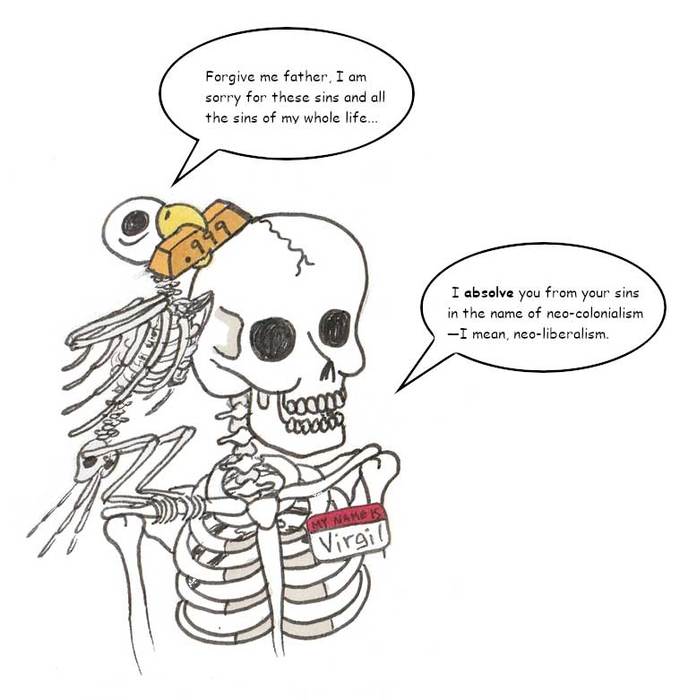
OK, OK, despite all this, there’s still validity to the chain of custody approach, derecho?
Let us for a moment approach Council with the generous spirit of many of my ethical jewelry colleagues. “It’s all going in the right direction…” We just need to work together.
Let’s ignore the issue of the past. Surely there is some benefit to being able to trace minerals based upon a single company’s mined product, and there is veracity in their certification process?
And, surely a certified mining company goes through a real audit process?
Bien, laLondon Mining Network points outaquí that the first mining company certified by the Council was Rio Tinto. This took placewithout an auditing or certification process, en 2012, just in time to supply gold to produce Olympic medals.
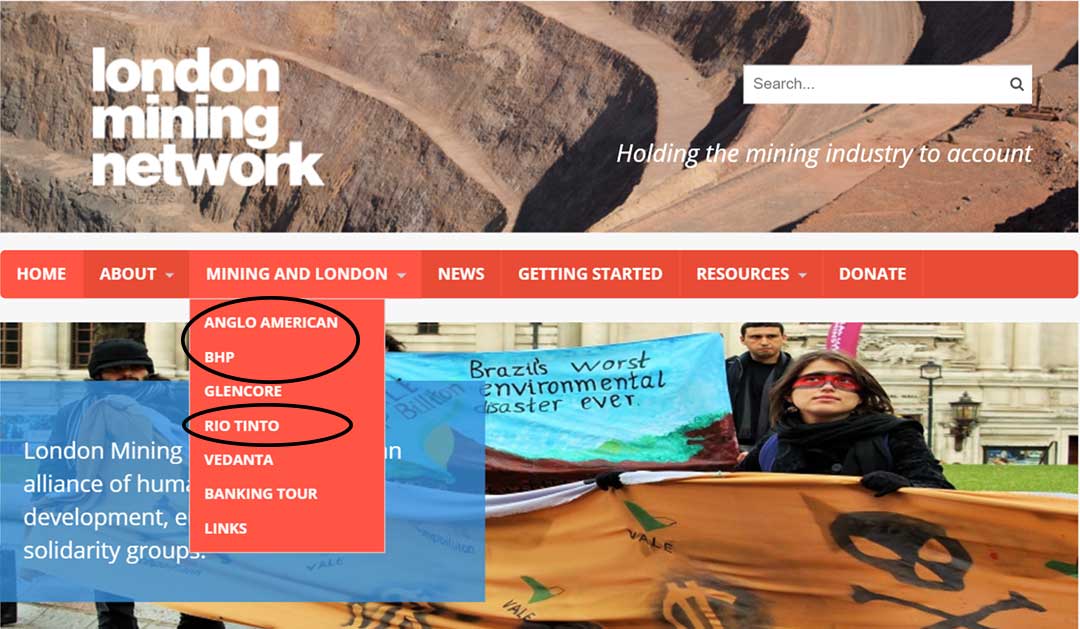
London Mining Network also points out Tinto’s environmental and human rights atrocities, que no sería relevante en un esquema de certificación centrado exclusivamente en la cadena de custodia.
This2015 exposé from Ojo Público documenta cómo dos empresas mineras certificadas del Consejo de Joyería Responsable, Metalor y Italpreziosi, procesó oro sucio ilegal desde el Amazonas hasta los mercados internacionales. No hay control de la cadena de custodia allí, sin embargo, todavía están certificados ...
(Shreema Mehta de Earthworks usa este ejemploen su articulo volver a señalar que el Consejo debería estar "Asegurando que las comunidades afectadas, los sindicatos y los grupos de la sociedad civil tienen un asiento igual en la mesa de toma de decisiones. Las consultas e invitaciones para participar en subcomités no son suficientes ". Su sugerencia es que el Consejo "limpie su acto" al "emitir certificados a minas específicas y fábricas, no corporaciones,"Y" cancelar inmediatamente los certificados de Metalor e Italpreziosi ".)
Estos dos artículos de investigación más recientes de abril, 2018, (ambos en español) deOjo Públicoyla República documentar cómo el miembro del Consejo Metalor continúa operando ilegalmente.

Este tipo de falta de supervisión es la razón por la cual los vigilantes de la industria han argumentado que el proceso multisectorial del Consejo diseñado en torno a la trazabilidad y la transparencia carece de veracidad..
Los detalles sucios
Analicemos cómo los estándares que parecen sólidos en el exterior no son tan efectivos. El 2018Informe HRW señala que:
“Once the auditors complete their report, they only submit a summary report of the audit to the RJC, not the full audit report, which is shared only with the company. Based on the summary report and the auditor’s recommendation, the RJC then determines whether a company should be certified. The RJC does not make the audit or its summary public. allowing companies to be RJC -certified even if they fail to meet basic human rights standards.”
They also state:
“…the Code of Practices allows companies to exclude facilities from the scope of its certification where it does not have full control, meaning more than 50 percent ownership. As a result, certification may exclude operations of significant size. Por ejemplo, Rio Tinto has excluded the Grasberg gold mine in Indonesia, of which it owns 40 por ciento, from its RJC certification scope. The Grasberg mine has been the site of numerous deaths of workers and other labor rights issues.”
The Responsible Jewellery Council’s core function as a trade association, uncollaboration between companies, overrides the veracity of their own self-generated and highly controlled standards-setting model.
10,000 Critical Breaches
Finalmente, let’s conclude this section on the Responsible Jewellery Council with a few more lines from that2009 Michael Rae interview:
Greg Valerio: “Are you saying that if a large-scale mining company like Rio Tinto, who was a founding member of RJC failed to meet the standards in the mining supplement, you would throw them out?"
Michael Rae: “Yes, we would have to. The organization would have no credibility unless there is a consequence to failing to conform with the standards that are set down. And like any other similar sort of system, hablamos de infracciones críticas que necesitan ser señaladas a nuestra atención y pueden resultar en la expulsión ".
¿Qué tipo de "infracciones críticas" realmente darían lugar a la expulsión?? No son cuestiones medioambientales. No son cuestiones de derechos humanos. ¿Qué tal una supuesta complicidad en el genocidio??
Por cuarenta y cinco años, Rio Tinto era el accionista mayoritario de la mina Panguna en Nueva Guinea, whicheste artículo de ABC News los estados fueron operados bajo condiciones de "esclavitud", y fue la ubicación del genocidio de Bougainville, que reclamó la vida de 10,000 personas. Tinto trató de salir de la demanda resultante de la masacre, but the 9ª El Tribunal de Circuito confirmó la queja del demandante.
Aquí hay información sobre elcontexto histórico de esta mina—Y otro recurso, delineando unletanía de los problemas de Rio Tinto, including their hiring of Henry Kissinger to sort out some problems.
(On top of all this, the mine was an environmental catastrophe—but in 2016, according to Papua New Guinea Mining Watch, Tinto walked away from its environmental responsibilities.)

I always find round numbers, tal como 10,000, particularly perfidious.
Why not 10,032? Or 10,181? If these were American casualties, we would expect this kind of precision.
In theBougainville Manifesto, Leonard Fong Roka provides social and historical context to the genocide. He puts the number at between 10,000 y 15,000 personas:
“Bougainville was caught up in the imperialist search for raw resources for industrialisation in Europe. From the simple barter of copra to European goods, the trade moved to labour exports, to the development of plantations on Bougainville and then to labour imports into Bougainville. This process secured Bougainville and Bougainvilleans for exploitation and the subjugation of their land. We became nobodies.”
“WE BECAME NOBODIES.”
Let us take a current example for comparison. I am 100% certain that every serious ethical jeweler feels moral outrage at the immigration policy which has separated children from their parents.
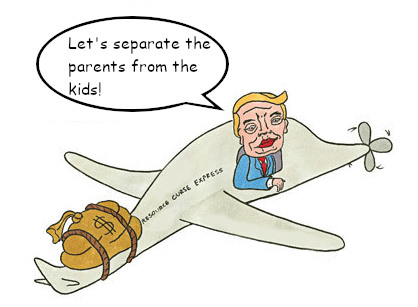
Yet the pain of those children we see in articles is minimal compared to the pain that would be caused in a scenario in which the parents or children were killed.
These round numbers, rough estimates of the deaths of Indigenous people, are easily glanced over without the slightest proximity to the pain.
But the proximity is important. It’s grabbing a live wire that leads to the heart of jewelry sourcing, and terrible awe at our collective human experience which jewelers working on ethical issues must be willing to latch on to if we are to be real change agents.
These numbers and their vague estimations underscore the point that that the lives of those Indigenous, dark-skinned people seem to not matter. These are just “nobodies”.
Michael Rae and the Responsible Jewellery Council, and all those who support them, do not see the incident or other past issues which require true investigation, truth, reconciliación, and restitution, as “critical breaches.”
The nobodies are powerless, past and voiceless ghosts.
Explore the Entire Ethical Jewelry Exposé

**All writing and images are open source, underCreative Commons 3.0. Any reproduction of this material must back link to the landing page, aquí. For high resolution images for publication, contact us at expose(AT)reflectivejewelry.com.**

